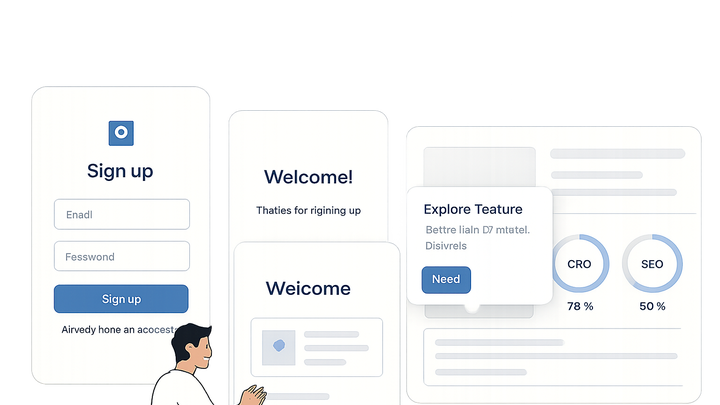Published on 2025-06-29T20:10:22Z
What is Onboarding Flow? Examples of Effective Onboarding Flows
Onboarding flow refers to the sequence of screens, messages, and interactions that guide a new user through the initial experience with a website or application. A well-crafted onboarding flow introduces the product’s value proposition, reduces friction, and familiarizes users with key features. In the context of CRO, UX, and SEO, optimizing your onboarding flow can significantly boost sign-up rates, engagement, and search visibility. Tools like Prevue.me provide actionable critiques across CRO, lead generation, SEO, UX, and accessibility to refine each step of the onboarding process. Whether you’re designing a simple sign-up form or a multi-step interactive tour, focusing on clarity, personalization, and continuous testing is essential for maximizing conversions and reducing churn.
By tailoring content to user segments and employing progressive disclosure, you can minimize initial overwhelm and build confidence as users discover advanced functionality. Incorporating analytics to track behavior and iterating based on data-driven insights ensures your flow remains effective as your product evolves.
Onboarding flow
The onboarding flow guides new users through key steps, showcasing value, reducing friction, and driving conversions through UX, CRO, and SEO optimizations.
Why Onboarding Flow Matters
The onboarding flow sets the stage for every new user interaction, impacting first impressions, conversion rates, and long-term retention. It determines whether users understand your product’s value quickly or abandon due to confusion. Effective onboarding can reduce bounce rates, increase engagement, and lead to more organic growth through positive user reviews and referrals.
-
First impressions
The initial screens and messages a user encounters shape their perception. A clear, concise introduction builds trust and encourages users to proceed.
-
Driving conversions
A streamlined, intuitive onboarding process reduces friction, guiding users to complete key actions like sign-up or feature activation.
-
Reducing churn
By educating users and showcasing value early, onboarding flows help prevent drop-offs and encourage continued use.
Core Elements of an Effective Onboarding Flow
Building an onboarding flow around best practices ensures users receive the right information at the right time. Focus on clarity, progressive disclosure, and personalization to maximize comprehension and engagement.
-
Clear value proposition
Communicate the unique benefits of your product upfront to motivate users to continue.
-
Progressive disclosure
Introduce features gradually to avoid overwhelming users while still showcasing advanced capabilities.
- Minimize initial overwhelm:
Display only essential information and steps at the start, revealing more as users progress.
- Build confidence:
Allow users to master basic functions before moving on to advanced features.
- Minimize initial overwhelm:
-
Interactive guidance
Utilize tooltips, modals, and walkthroughs to direct users’ attention to critical elements and actions.
- Tooltips:
Provide contextual hints that appear on hover or focus for in-the-moment assistance.
- Guided tours:
Offer step-by-step walkthroughs to familiarize users with main workflows.
- Tooltips:
-
Personalization
Tailor the onboarding experience based on user segments, behavior, or preferences to increase relevance.
Optimizing Onboarding Flow for CRO, UX, and SEO with Prevue.me
prevue.me provides comprehensive audits and actionable critiques across multiple dimensions to refine your onboarding flow. By combining automated analysis with expert insights, you can optimize each step for higher conversions, better usability, and search performance.
-
Actionable cro insights
prevue.me evaluates your onboarding pages for conversion blockers and suggests improvements to CTAs, form fields, and layout.
- Cta placement and wording:
Ensure call-to-action buttons are prominent, concise, and aligned with user intent.
- Form optimization:
Reduce the number of fields, use inline validation, and leverage autofill to minimize friction.
- Cta placement and wording:
-
Ux and accessibility critiques
Gain insights on usability and compliance with accessibility standards to make your flow inclusive.
- Navigation clarity:
Assess menu labels, progress indicators, and step sequencing to keep users oriented.
- Color contrast and readability:
Test text contrast ratios, font sizes, and spacing to cater to users with visual impairments.
- Navigation clarity:
-
Seo considerations
Optimize onboarding pages for search engines to attract users through organic channels.
- Metadata optimization:
Craft descriptive title tags and meta descriptions that highlight key benefits and include relevant keywords.
- Page speed assessment:
Identify and fix performance bottlenecks to improve load times, which impact both UX and SEO.
- Metadata optimization:
Best Practices and Continuous Improvement
An onboarding flow is never finished. Regular testing, user feedback, and analytics monitoring are crucial for ongoing optimization.
-
A/b testing
Experiment with different flows, CTAs, and messaging to identify the highest-converting variant.
-
Analytics tracking
Use event tracking and funnel analysis to pinpoint drop-off points and measure improvements over time.
-
User feedback loops
Collect qualitative feedback through surveys and interviews to understand user motivations and pain points.
